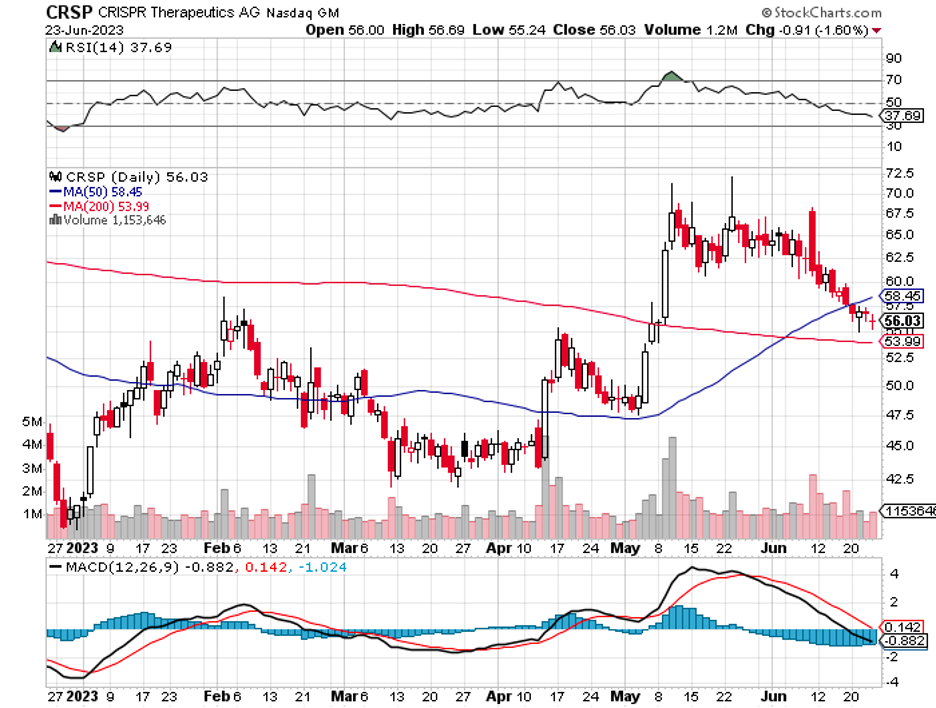The investing world is a roller coaster where investors' enthusiasm can experience sharp rises and precipitous drops.
One classic case study is CRISPR Therapeutics (CRSP), whose stock is currently hovering around $61 per share, a far cry from its zenith of $220.20 back on January 15, 2021.
But don't write off this biotech player yet; it's poised for a resurgence, and here's why.
The company is in the final stages of commercializing its pioneering gene therapy, exa-cel. This novel treatment, developed in collaboration with Vertex Pharmaceuticals (VRTX), aims to redefine the treatment landscape for patients battling transfusion-dependent beta-thalassemia (TDT) and sickle cell disease (SCD).
With approval requests already lodged with regulatory bodies, the company could be on the cusp of a financial windfall by Q2 2024, sending its stock skyward.
Shining a spotlight on this exa-cel opportunity, it's important to understand that current treatment options for blood disorders are far from ideal, involving blood transfusions and frequent hospital stays. Both physicians and patients are likely ready for a less disruptive alternative.
Exa-cel could be a game-changer for CRISPR, obviating the need for lifelong blood transfusions for certain SCD and TDT patients.
The Institute for Clinical and Economic Review (ICER) recently suggested that the therapy could fetch a staggering $1.9 million per treatment. Meanwhile, the treatment is projected to reach global sales of $1.7 billion by 2028, propelling it into the blockbuster category.
Even with Vertex claiming a majority 60% share of profits, the opportunity remains substantial for CRISPR.
CRISPR and Vertex are primed to address the needs of the most critically ill patients, estimated to be around 32,000 in the U.S. and Europe.
The real charm, however, lies in CRISPR's potential for sustainable long-term growth.
The approval of exa-cel doesn't just promise immediate benefits but also unlocks the potential of the company's pipeline, acting as a proof of concept for CRISPR's gene-editing methodology.
Fast-forward a decade, and the company might boast a portfolio of blockbuster therapies.
Among these potential stars is CTX310, set to enter clinical trials soon. CTX310 is one of the company's few in-vivo therapies, delivering therapeutic genes, gene modulators, and gene-editing tools directly into patient cells.
CTX310 targets angiopoietin-related protein 3 (ANGPTL3) to mitigate the risk of cardiovascular disease, a prevalent concern linked to high rates of coronary artery disease.
In contrast to the relative rarity of SCD and TDT, coronary artery disease is the most common heart disease in the U.S., claiming 375,476 lives in 2021, according to the Centers for Disease Control and Prevention.
Another contender in the pipeline is CTX110, currently under testing for B-cell cancers, including B-cell lymphomas, acute lymphoblastic leukemia (ALL), and chronic lymphocytic leukemia (CLL).
The drug showed promising results in a phase 1 trial to treat large B-cell lymphoma, reporting an objective response rate of 67% and a complete response rate of 41% in patients with significant prior treatment.
The future looks promising for CRISPR's quartet of chimeric T-cell (CAR-T) therapies -- CTX119, CTX130, CTX112, and CTX131 -- being developed as cancer therapies. These therapies target specific proteins to suppress tumors or provoke an immune response.
Contrasting the typical clinical-stage biotech company, CRISPR, thanks to collaborative revenue, is in a healthier financial position.
As of Q1, CRISPR had $1.89 billion in cash reserves, ample to fund operations for the next three years. With potential exa-cel approval, these funds could further fuel research and development.
While it's hard to predict precisely where CRISPR will stand in a decade, its roadmap sets it apart from most clinical-stage biotech firms. The company has already demonstrated its ability to advance its science. Its success, though, will hinge on its capacity to transition into marketing and to manufacture its products.
Given its promising future, I see CRISPR Therapeutics as an excellent investment. Even though I've tempered my expectations about the market opportunity and challenges confronting both Vertex and CRISPR, the potential for exa-cel, which could rake in billions of dollars and serve as a functional cure, lends itself to investor optimism.
In the past, CRISPR shares have breached the $190 mark, translating to a near $20 billion market cap, or over 4x its current valuation. Granted, a fully commercialized pharma typically trades at around 5x sales, but an experimental pharma with a robust pipeline can trade at 50x sales without necessarily appearing overvalued. After all, pharma investing is about betting on future potential, or as we call it, "jam tomorrow."
Taking a long-term perspective and factoring in the cash reserves of over $1 billion, the potential to broaden the SCD/TDT market with Exa-cel 2.0 and 3.0, the technology validation, other pipeline assets, and a solid partner in Vertex, I believe CRISPR's stock is poised to reclaim a price above $100 in due time. There may be some turbulence along the way, but I anticipate exa-cel will one day fuel blockbuster sales exceeding $1 billion annually.
For context, consider Alnylam (ALNY), a drug developer in the field of RNA interference, which generated just over $1 billion in sales last year at a net loss of over $1 billion, yet sports a market cap of $25.1 billion.
With this perspective, the future for CRISPR looks bright indeed.


